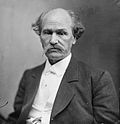Top Qs
Timeline
Chat
Perspective
List of governors of Tennessee
From Wikipedia, the free encyclopedia
Remove ads
The governor of Tennessee is the head of government of the U.S. state of Tennessee.
Tennessee has had 50 governors, including the incumbent, Bill Lee.[1] Seven governors (John Sevier, William Carroll, Andrew Johnson, Robert Love Taylor, Gordon Browning, Frank G. Clement, and Buford Ellington) have served non-consecutive terms. This tally does not include William Blount (the territorial governor) or Robert L. Caruthers (who never took office), though the Blue Book includes them in its list of governors.[2] All governors are counted only once, regardless of number of terms served (e.g., John Sevier is considered the 1st governor, rather than the 1st and 3rd governor). The Blue Book does not include Edward H. East in its list of governors.
Remove ads
List of governors
Summarize
Perspective
Southwest Territory
The Territory South of the Ohio River, commonly known as the Southwest Territory, was organized on May 26, 1790.[3]
Throughout its 6-year history, Southwest Territory had only one governor appointed by the federal government, William Blount.
State of Tennessee
Southwest Territory was admitted to the Union as Tennessee on June 1, 1796.[7]
The first constitution of Tennessee, enacted in 1796, set a term of two years for the governor and provided that no person could serve as governor for more than 6 years in any 8-year period.[8] The term of office was lengthened to four years, without the possibility of consecutive terms, by constitutional amendments adopted in 1953.[9] Under the current provisions of the state constitution, as amended in 1978, the governor is elected to a four-year term and may serve no more than two terms consecutively.[9][10]
Remove ads
See also
Notes
- Under the 1796 constitution, governors were ineligible to serve more than six years in any term of eight.[14]
- Houston resigned with no specific reasoning, but it was during the collapse of his marriage.[26]
- Johnson was instead elected to the United States Senate.[56]
- Harris fled Nashville for Memphis after the Battle of Fort Donelson in February 1862, and was later driven from the state by Union forces as he worked with the Confederate army.[59] Johnson was appointed military governor of Tennessee on March 12, 1862, by the Union forces occupying Middle and East Tennessee.[56] Meanwhile, the Confederate-held portions of West Tennessee held an election in August 1863, in which Harris would have been term-limited, and elected Robert L. Caruthers governor. However, as the legislature was unable to convene, Caruthers was never able to take office.[15][62]
- Johnson resigned, having been elected Vice President of the United States.[56][15]
- Brownlow resigned, having been elected to the United States Senate.[66]
- Frazier resigned, having been elected to the United States Senate.[100]
- Patterson received the Democratic nomination, but withdrew after a schism in the party.[109]
- Under the 1870 constitution, governors were ineligible to serve more than six years in any term of eight.[137]
- Under a 1953 amendment to the constitution, governors were ineligible to succeed themselves.[145]
- Represented the Democratic Party
- Under a 1978 amendment to the constitution, governors are ineligible for election to more than two consecutive terms.[159]
- Represented the Republican Party
- Lee's second term began on January 21, 2023,[170] and will expire on January 16, 2027; he will be term-limited
Remove ads
References
External links
Wikiwand - on
Seamless Wikipedia browsing. On steroids.
Remove ads



















































